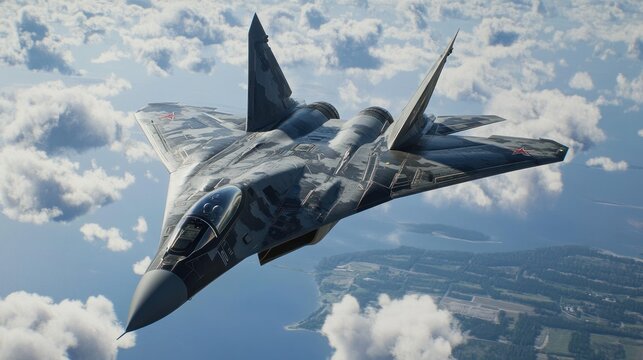Unraveling Justice: Why ‘Haq Movie’ is the Most Anticipated Courtroom Drama of 2025
The Sukhoi Su-57 : Russia’s Bold Leap into Fifth-Generation Air Superiority

Su-57
Su-57 : In the high-stakes world of modern aerial warfare, where stealth and speed can mean the difference between victory and vulnerability, Russia’s Sukhoi Su-57 stands out as a fascinating engineering marvel. Dubbed the “Felon” by NATO, this fifth-generation multirole fighter is more than just a machine—it’s a symbol of Russia’s determination to reclaim its place among the elite in fighter jet technology. As we hit the midpoint of the 2020s, with production ramping up amid global tensions, let’s dive into what makes the Su-57 tick, from its turbulent development to its cutting-edge capabilities and real-world deployments.
A Rocky Road to the Skies: Development and History
The Su-57 didn’t emerge overnight. Its story begins in the late Soviet era with the ambitious I-90 program in 1979, aimed at creating a fighter for the 1990s. Economic turmoil after the USSR’s collapse stalled progress, leading to canceled prototypes like Mikoyan’s Project 1.44. Fast-forward to 1999, and Russia relaunched the effort under the PAK FA (Prospective Airborne Complex of Frontline Aviation) banner. Sukhoi clinched the contract in 2002, leveraging its Su-27 heritage, and the first prototype—the T-50—took to the skies on January 29, 2010.

Challenges abounded: engine troubles, a 2019 crash of the first production model, and the 2018 fallout with India over the joint FGFA program (due to cost and tech-sharing disputes). Yet, perseverance paid off. Serial production kicked off in July 2019, with the first delivery to the Russian Aerospace Forces (VKS) in December 2020. By late 2025, the jet has officially entered service since December 2019, though full operational capability remains a work in progress.
What sets the Su-57 apart? It’s Russia’s first true stealth fighter, blending low observability with supermaneuverability, supercruise speeds, and sensor fusion. Designed to phase out aging Su-27s and MiG-29s, it’s also a testbed for future stealth tech, including potential drone-swarming capabilities.
Design and Tech: Su-57 Stealth Meets Agility
At first glance, the Su-57’s blended wing-body design screams “stealth.” Its radar cross-section (RCS) is a mere 0.1–1 m²—dwarfed by the 10–15 m² of its predecessors—thanks to aligned edges, radar-absorbent coatings, and serpentine inlets that hide the engines from prying radars. Twin AL-41F1 turbofans (with upgrades to the more efficient AL-51F1 on the horizon) provide 3D thrust-vectoring for Cobra-like maneuvers that defy physics.
The cockpit is a pilot’s dream: an active electronically scanned array (AESA) N036 Byelka radar, infrared search and track (IRST) for passive targeting, and modular avionics for seamless data sharing in network-centric battles. Composites make up 22–26% of the airframe, keeping it light yet tough, while internal bays ensure weapons stay hidden during stealth ops.
Here’s a quick spec breakdown to geek out over:
| Feature | Details |
| Crew | 1 (with two-seat variant planned) |
| Dimensions | Length: 20.1 m; Wingspan: 14.1 m |
| Weights | Empty: 18,500 kg; Max Takeoff: 35,000 kg |
| Engines | 2 × AL-41F1 (up to 142.2 kN afterburner) |
| Top Speed | Mach 2 (2,135 km/h) |
| Supercruise | Mach 1.3 (1,400 km/h) |
| Range | 3,500 km subsonic |
| Ceiling | 20,000 m |
| Armament Payload | Up to 10,000 kg (internal/external) |
Armed to the teeth, it packs R-77M air-to-air missiles, Kh-69 cruise missiles for ground strikes, and even hypersonic Kinzhal derivatives. A 30 mm GSh-30-1 cannon rounds out the close-quarters punch.

From Syria to Ukraine: Combat Proven?
The Su-57’s baptism by fire came in Syria in 2018, where it logged 10 sorties, firing Kh-59MK2 missiles without a hitch. But the real test? The ongoing Russo-Ukrainian War. Since late 2022, it’s been used for standoff strikes from Russian soil, avoiding frontline risks. As of October 2025, fewer than 25 are combat-ready, with Ukrainian drones reportedly damaging one in June 2024. The VKS’s 23rd Fighter Aviation Regiment at Akhtubinsk handles most ops, and recent border deployments with China signal growing interoperability.
Production lags due to sanctions—only six deliveries in 2024—but 2025 shows promise. Leaked docs from August reveal early birds flying “lite” without full pods, but the Su-57M upgrade (with AI smarts and better engines) is in trials, eyeing a mid-decade rollout.
Global Ambitions: Exports and Rivals
Russia’s not keeping this bird caged. Algeria locked in an order in February 2025, and the export-tuned Su-57E turned heads at Zhuhai 2024 and Aero India 2025—parked cheek-by-jowl with the F-35. Talks for Indian co-production bubbled up in September, though Delhi’s eyeing the cheaper Su-75 Checkmate too. At LIMA 2025 in Malaysia, the Su-57M stole the show.
Stack it against the F-35? The Su-57 wins on raw speed and range but trails in all-aspect stealth and sensor maturity. It’s a trade-off: agility for the skies versus invisibility in the electromagnetic fog.
Also Read This : WhatsApp vs Arattai : The Ultimate Messaging App Showdown for India in 2025
The Future Skies: What’s Next for the Felon?
As geopolitical winds shift, the Su-57 embodies Russia’s push for self-reliance in defense tech. With upgrades like drone control and hypersonic integration, it could redefine multirole fighters. But hurdles remain—sanctions, funding, and proving itself beyond Russia’s borders.


